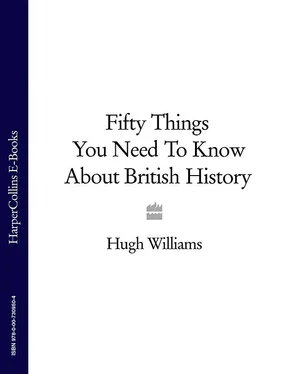The Origins of Britain
When I was young we used to go on holiday to Anglesey, off the coast of North Wales. Our long drive would eventually take us across the Menai Bridge, Thomas Telford’s great feat of engineering constructed between 1819 and 1826 to speed up the journey to the port of Holyhead. When it was built no suspension bridge had been designed on such a scale before. Today it is a ‘World Heritage Site’. My father was Welsh and as we drove across he would recite a Welsh poem all about it. I cannot remember who it was by – probably the poet David Owen who wrote a number of poems about Menai – but I can remember that he tried to get my brother and me to recite it too. We never managed more than a few words. The Welsh language, despite our parentage, has remained a closed book to us. But sweeping across Telford’s beautiful masterpiece high above the waters of the Menai Straits, my parents’ ancient Austin looking forward like an exhausted horse to the end of the interminable drive, I felt a bit Welsh, a bit different and rather special. I felt I had roots. I was something more than just an ordinary little London schoolboy.
Over the past thirty years people in Britain have spent a lot of time returning to their roots. The fashion for devolution with the establishment of a parliament in Scotland and an assembly in Wales, combined with the long struggle to find political stability in Northern Ireland, have affected our sense of nationhood. Which comes first – our Britishness, our Scottishness, Welshness or Englishness? Meanwhile, beyond the shores of the United Kingdom, our national interests are being absorbed into the common objectives of the European Union and constantly tempered by increasing globalisation. Outside we are hurrying to be part of a bigger world: at home, it seems, we want to be part of a smaller one. Who we are and where we come from have become increasingly important as a shrinking world seeks to suck our national identity out of us.
This chapter goes in search of who the British are and where they came from. It begins with Stonehenge, an enigmatic monument to the people who inhabited the country in its earliest times, and as good a place as any in which to invest our sense of history.
The Romans were the first people to give Britain shape. They occupied it for 400 years, but after they withdrew the order they had created collapsed into chaos. Slowly, very slowly, order began to return. It came first through the messages of the Christian missionaries, particularly Saint Augustine, who brought back the ideas of Rome, by then a Christian city, to the island which had been abandoned 200 years before. It was enlarged and developed by the Anglo-Saxon kings, the greatest of whom was Alfred the Great, King of Wessex.
Britain succumbed to invasion for the last time in 1066 when the Normans became its rulers, destroyed the Anglo-Saxon way of life and started to lay the foundations of the medieval state. The Catholic Church and the monarchy held the country in their grasp until the Reformation broke them apart. Henry VIII’s dissolution of the monasteries in the sixteenth century was one of the most important acts in a process which would see the evolution of Britain into a nation state. Shakespeare helped give that nation its tongue.
In 1707 Britain joined with Scotland, but managed its relationship with its other neighbour, Ireland, far less successfully. The failure of the Home Rule movement in the nineteenth century would have disastrous consequences for both countries in the twentieth.
Today, in the twenty-first century, Britain is a part of Europe and shares its national aspirations with twenty-seven other countries. The island which carved its identity by withdrawing from the shifts and changes of a continent in turmoil has re-entered the arena from which it came. Once again Britain is replanting its roots.
CHAPTER 1
3100 to 2200 BC
The huge and ancient stone monument known as Stonehenge, in Wiltshire, is one of Britain’s oldest monuments. Its origins are uncertain. It is surrounded by myth and legend. It belongs to the beginning of Britain.
Stonehenge is an island of antiquity stranded in a twenty-first century melting pot .
If you drive east to west across southern England you may well pass Stonehenge. It stands just a few hundred yards back from the A303, one of the country’s busiest main roads taking traffic to and from the West Country. Travelling westwards you are more than likely to have time to get a good view of it because it is here that the fast dual carriageway funnels into a two-lane road and the traffic queues can be enormous. Stonehenge is an island of antiquity stranded in a twenty-first century melting pot. At this point the journey west crosses a bridge of nearly 5,000 years of history as the achievements of the most ancient rites of man stare stonily towards his most recent and most frenetic.
Stonehenge was built in different phases over many hundreds of years. To begin with, in about 3100 BC, it was a circular ditch with an internal bank and fifty-six holes around its perimeter. A few hundred years later two circles of bluestone were erected. Bluestone is not native to Wiltshire but comes from the Preseli Hills in Pembrokeshire in West Wales. After that the bluestones were dug up and rearranged and the familiar sarsen stones brought to the site. These form Stonehenge’s most famous image of the pillars with lintels across the top. The sarsen stones came from Avebury, about 18 miles to the north. In the last phase, about 2200 BC, the bluestones were put back again to form a circle and a horseshoe inside the sarsen pillars. All these different arrangements took place over hundreds of years and leave many questions unanswered. What was Stonehenge for? Who built it? How did the bluestones get from Wales to Wiltshire? Throughout the history of Britain people have tried to answer these questions, adapting their answers to suit the age in which they live.
In the twelfth century Henry of Huntingdon wrote a history of the English people from the Roman invasion to the reign of Henry II. He described Stonehenge as one of the four wonders of Britain but declared that no one knew why it had been built, or by whom. His contemporary, Geoffrey of Monmouth, came up with a rather more colourful account. Stonehenge, he said, was constructed as a memorial to nobles who had been slain in battle by the Saxon chieftain, Hengist. He dates the origin of the monument to the time of Aurelius Ambrosius, who emerged from the chaos following the Romans’ retreat to lead Britain in its war against the Saxons. According to legend, Ambrosius was the uncle of King Arthur and having decided to build the monument sought advice from the magician Merlin. Merlin told him of a stone circle in Ireland called the giants’ dance. Ambrosius sent his men to fetch it and, with Merlin’s help, they brought it back to Wiltshire. A sacred ceremony was held at Stonehenge where Ambrosius was crowned as king of his people: myth and ritual were even then part of its story.
In the seventeenth century, James I, always interested in scholarship, asked his Surveyor-General, Inigo Jones, to carry out an investigation into the reasons why Stonehenge was built. Inigo Jones was a great architect but a somewhat naive archaeologist. His love of classical antiquity influenced the design of the magnificent buildings he built for his king in London, but they got him off on the wrong foot as far as Stonehenge was concerned. He came to the conclusion that it was a Roman temple to the god Coelus. Once again the influences of the age, rather than historical accuracy, had been used to determine the origins of this ancient monument.
Later in the seventeenth century, another study of Stonehenge began to get a bit closer to the truth. John Aubrey was an antiquarian, biographer and gossip whose book, Brief Lives , is a highly entertaining account of many of the most distinguished people of the time. He was interested in objects as much as people and recorded his observations of Stonehenge in a book about British monuments. In particular he noticed the depressions or holes around the perimeter of the original ditch, which have since been called the ‘Aubrey Holes’ in his honour. He surmised correctly that Stonehenge belonged to an early British civilisation, but in trying to locate its origins more exactly he came up with the idea that it was a Druid temple. This thought fuelled the imagination of the eighteenth century. The concept of a mysterious ruin set in a quiet landscape, its eerie history of ceremony and sacrifice blending with the force of nature played perfectly into the romantic ideas of the time. Stonehenge obligingly fell in with fashion.
Читать дальше












